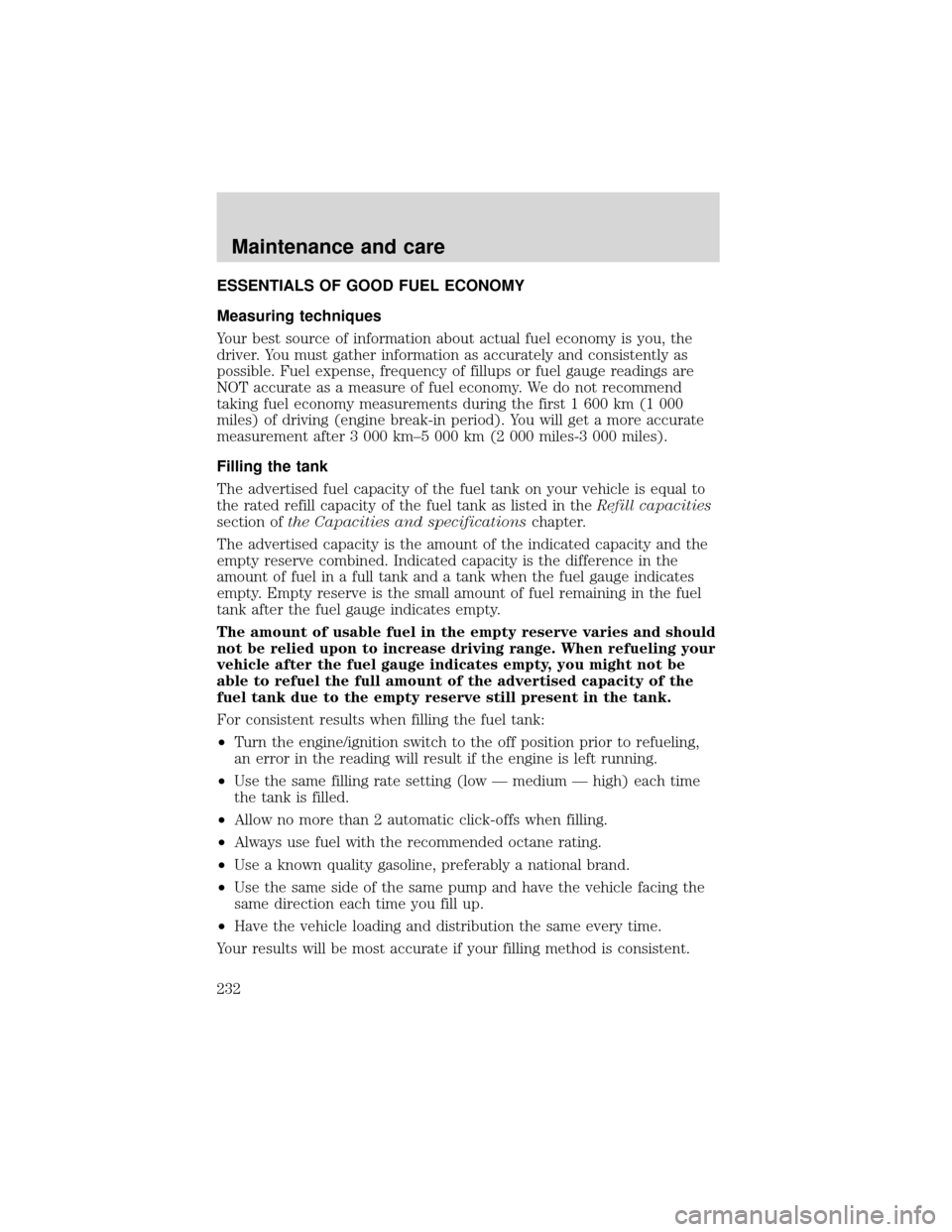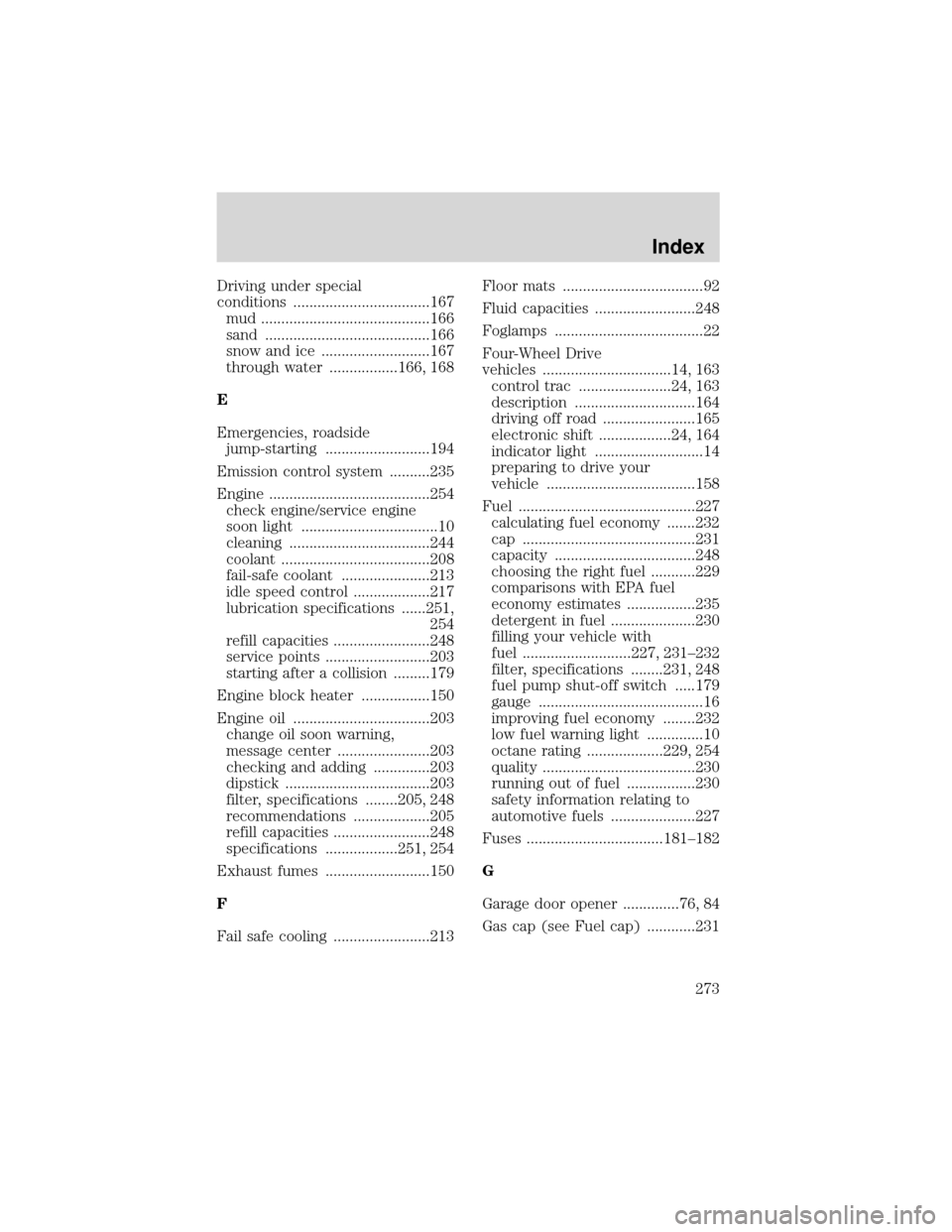Page 230 of 280

Fuel quality
If you are experiencing starting, rough idle or hesitation driveability
problems during a cold start, try a different brand of“Regular”unleaded
gasoline.“Premium”unleaded gasoline is not recommended (particularly
in the United States) because it may cause these problems to become
more pronounced. If the problems persist, see your dealer or a qualified
service technician.
It should not be necessary to add any aftermarket products to your fuel
tank if you continue to use high quality fuel of the recommended octane
rating. Aftermarket products could cause damage to the fuel system.
Repairs to correct the effects of using an aftermarket product in your
fuel may not be covered by your warranty.
Many of the world’s automakers
issued the World-wide Fuel Charter
that recommends gasoline
specifications to provide improved
performance and emission control
system protection for your vehicle.
Gasolines that meet the World-wide
Fuel Charter should be used when
available. Ask your fuel supplier
about gasolines that meet the
World-wide Fuel Charter. In Canada,
look for fuels that display theAuto Makers’Choice�logo.
Cleaner air
Ford endorses the use of reformulated“cleaner-burning”gasolines to
improve air quality.
Running out of fuel
Avoid running out of fuel because this situation may have an adverse
affect on powertrain components.
If you have run out of fuel:
•You may need to cycle the ignition from OFF to ON several times after
refueling, to allow the fuel system to pump the fuel from the tank to
the engine.
•Your“Service Engine Soon”indicator may come on. For more
information on the“Service Engine Soon”indicator, refer to the
Instrumentationchapter.
Maintenance and care
230
Page 232 of 280

ESSENTIALS OF GOOD FUEL ECONOMY
Measuring techniques
Your best source of information about actual fuel economy is you, the
driver. You must gather information as accurately and consistently as
possible. Fuel expense, frequency of fillups or fuel gauge readings are
NOT accurate as a measure of fuel economy. We do not recommend
taking fuel economy measurements during the first 1 600 km (1 000
miles) of driving (engine break-in period). You will get a more accurate
measurement after 3 000 km–5 000 km (2 000 miles-3 000 miles).
Filling the tank
The advertised fuel capacity of the fuel tank on your vehicle is equal to
the rated refill capacity of the fuel tank as listed in theRefill capacities
section ofthe Capacities and specificationschapter.
The advertised capacity is the amount of the indicated capacity and the
empty reserve combined. Indicated capacity is the difference in the
amount of fuel in a full tank and a tank when the fuel gauge indicates
empty. Empty reserve is the small amount of fuel remaining in the fuel
tank after the fuel gauge indicates empty.
The amount of usable fuel in the empty reserve varies and should
not be relied upon to increase driving range. When refueling your
vehicle after the fuel gauge indicates empty, you might not be
able to refuel the full amount of the advertised capacity of the
fuel tank due to the empty reserve still present in the tank.
For consistent results when filling the fuel tank:
•Turn the engine/ignition switch to the off position prior to refueling,
an error in the reading will result if the engine is left running.
•Use the same filling rate setting (low—medium—high) each time
the tank is filled.
•Allow no more than 2 automatic click-offs when filling.
•Always use fuel with the recommended octane rating.
•Use a known quality gasoline, preferably a national brand.
•Use the same side of the same pump and have the vehicle facing the
same direction each time you fill up.
•Have the vehicle loading and distribution the same every time.
Your results will be most accurate if your filling method is consistent.
Maintenance and care
232
Page 273 of 280

Driving under special
conditions ..................................167
mud ..........................................166
sand .........................................166
snow and ice ...........................167
through water .................166, 168
E
Emergencies, roadside
jump-starting ..........................194
Emission control system ..........235
Engine ........................................254
check engine/service engine
soon light ..................................10
cleaning ...................................244
coolant .....................................208
fail-safe coolant ......................213
idle speed control ...................217
lubrication specifications ......251,
254
refill capacities ........................248
service points ..........................203
starting after a collision .........179
Engine block heater .................150
Engine oil ..................................203
change oil soon warning,
message center .......................203
checking and adding ..............203
dipstick ....................................203
filter, specifications ........205, 248
recommendations ...................205
refill capacities ........................248
specifications ..................251, 254
Exhaust fumes ..........................150
F
Fail safe cooling ........................213Floor mats ...................................92
Fluid capacities .........................248
Foglamps .....................................22
Four-Wheel Drive
vehicles ................................14, 163
control trac .......................24, 163
description ..............................164
driving off road .......................165
electronic shift ..................24, 164
indicator light ...........................14
preparing to drive your
vehicle .....................................158
Fuel ............................................227
calculating fuel economy .......232
cap ...........................................231
capacity ...................................248
choosing the right fuel ...........229
comparisons with EPA fuel
economy estimates .................235
detergent in fuel .....................230
filling your vehicle with
fuel ...........................227, 231–232
filter, specifications ........231, 248
fuel pump shut-off switch .....179
gauge .........................................16
improving fuel economy ........232
low fuel warning light ..............10
octane rating ...................229, 254
quality ......................................230
running out of fuel .................230
safety information relating to
automotive fuels .....................227
Fuses ..................................181–182
G
Garage door opener ..............76, 84
Gas cap (see Fuel cap) ............231
Index
273